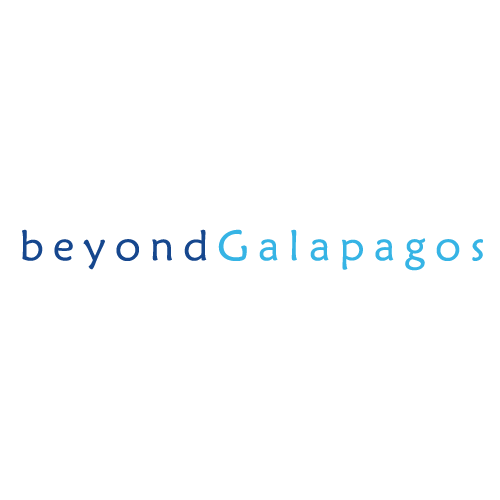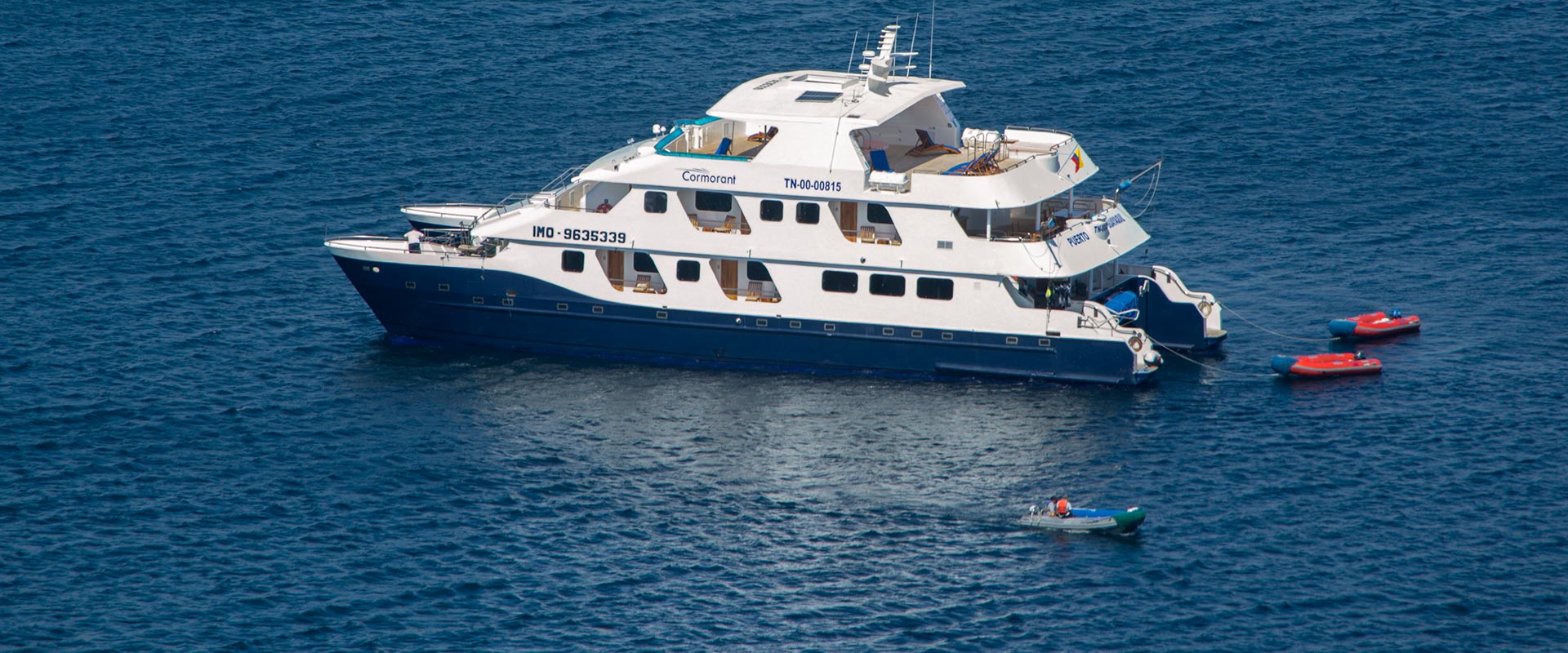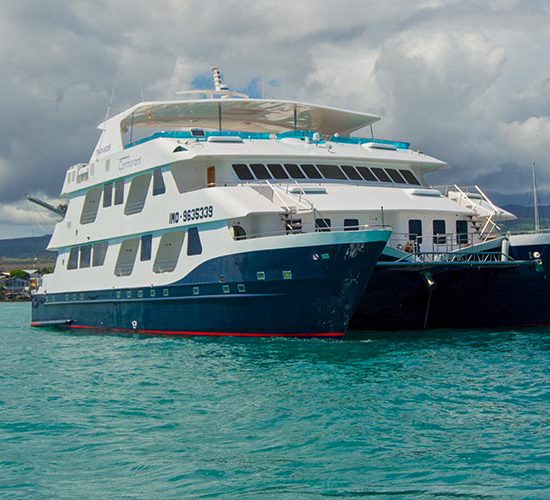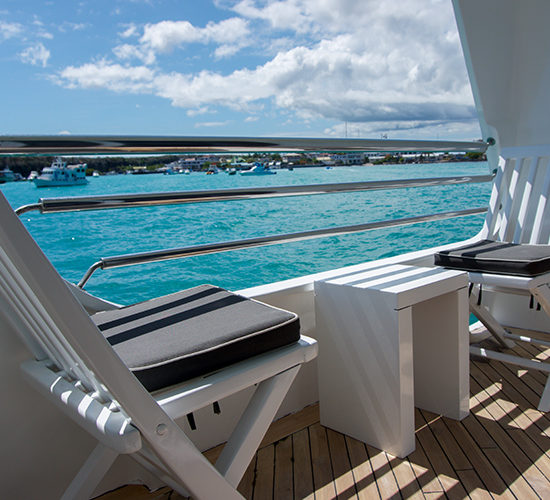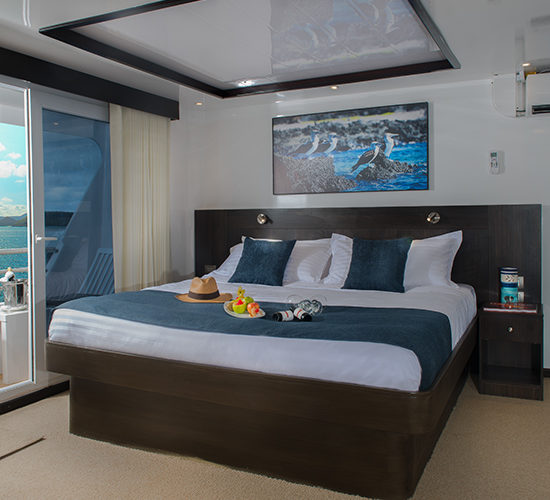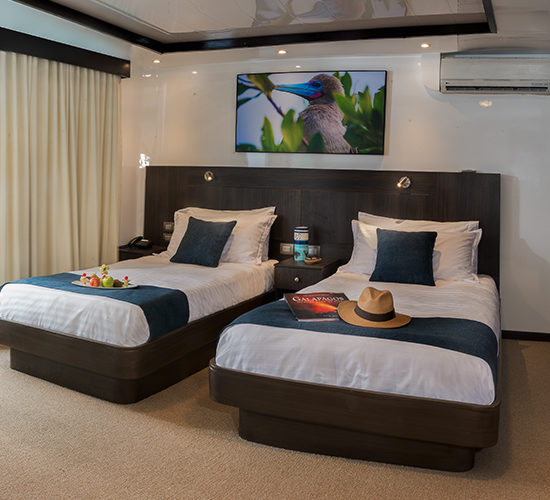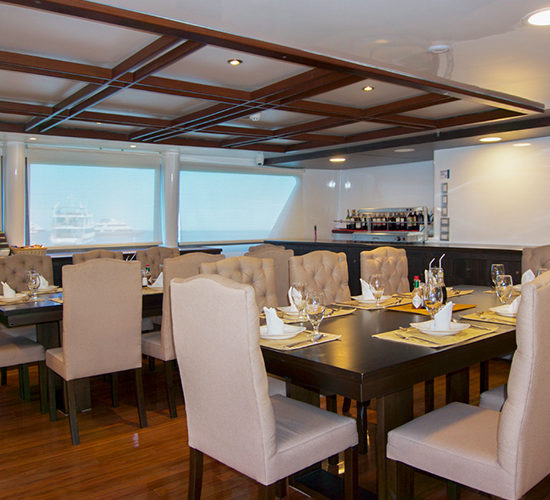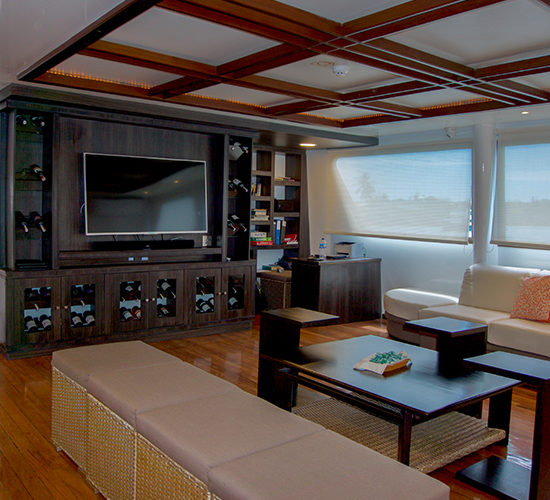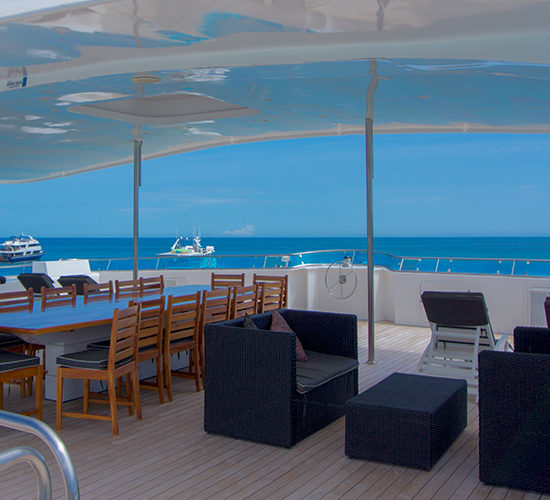Motor Catamaran Cormorant
SPECIAL FEATURES:
Capacity: 16 guests
Departure day: Wednesday & Saturday
Cruise length: 4, 5, 8 days
Available: Snorkelling equipment, wetsuits, underwater camera
Ideal for honeymoon or anniversary trips
Ideal for small groups charters
Islands to visit, depending on the itinerary:
4, 5, 8 days cruise Itineraries (A):
Santa Cruz Island, Bartolome Island, Santiago Island, South Plaza Island, Santa Fe Island, San Cristobal Island, Española Island, Floreana Island.
8-day cruise Itinerary (B):
Santa Cruz Island, Isabela Island, Fernandina Island, Santiago Island, Genovesa Island, North Seymour Island.
The Cormorant is a comfortable motor catamaran that offers you a good cruise through the Galapagos Islands
This lovely catamaran offers you an unforgettable Galapagos expedition, its ample and comfortable cabins with a private balcony give you the opportunity to relax and enjoy the wonderful views of this magical place. You can enjoy a delicious drink on the sun deck, with a wonderful sunset.
CORMORANT CATAMARAN - BRIEF ITINERARY
Please check complete itineraries on top
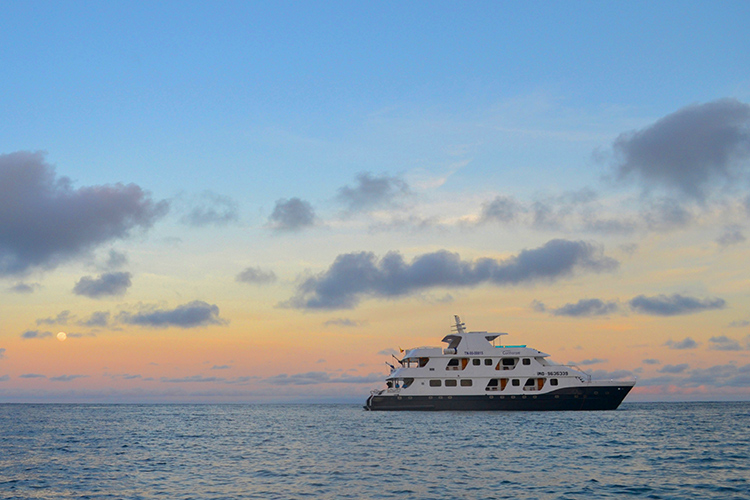
Saturday: Baltra & Santa Cruz Islands
- AM: Arrival at Baltra airport and transfer to the cruise
- PM: Santa Cruz Island – Bachas beach
Sunday: Bartolome & Santiago Islands
- AM: Bartolome Island
- PM: Santigo Island – Sullivan Bay
Monday: South Plaza & Santa Fe Islands
- AM: South Plaza Island
- PM: Santa Fe Island
Tuesday: San Cristobal Island
- AM: Witch Hill
- PM: Pitt Point
Wednesday: San Cristobal Island
- AM: Tortoise Breeding Center & Lobos Island
- PM: Kicker Rock
Thursday: Española Island
- AM: Suarez Point
- PM: Gardener Bay & Gardner Islet
Friday: Floreana Island
- AM: Cormorant Point & Champion Islet
- PM: Post Office Bay & Baroness lookout
Saturday: Santa Cruz Island – Tortoise Breeding Centre and transfer to the airport for your flight back to Quito or Guayaquil.
CORMORANT CATAMARAN - RATES
Rates are per person
| Cabin Type | 8 Days | 5 Days | 4 Days |
|---|---|---|---|
| Suite (2 available) | $7,475 | $4,715 | $3,500 |
| Staterooms (6 available) | $6,880 | $4,375 | $3,245 |
| Charter | $102,690 | $65,310 | $48,470 |
SPECIAL NOTES:
| Discount for groups of 6-14 pax | 10% |
| Discount for children under 12 years | 20% |
| Christmas and New Year supplement | 25% |
| Single supplement | 50% |
Included:
Accommodation
All Meals (from lunch on the first day to breakfast on last day)
Drinking water, coffee and tea
Guided visits with a naturalist guide
Use of snorkelling equipment
Use of wetsuits
Transfers to and from the airport in Galapagos
Additional:
Galapagos flight ticket
Galapagos entrance fee ($100 per adult & $50 per child, subject to change)
Galapagos migration card ($20 per person)
Soft and alcoholic drinks
Additional tours and transfers
Personal expenses
Meals that are not mentioned
Travel insurance (strongly suggested)
Tips & gratuities
All that is not mentioned
We'd love to help you plan your trip!
Please let us know about your plans
Ready to step into this expedition?
Please fill out the form let us guide you through your next dream holiday!
-
Departure/Return Location
Quito or Guayaquil | Baltra Island, Galapagos Islands -
Dress Code
Comfortable: Good walking shoes, cotton & light pants, shorts, t-shirts, windbraker for the nights, cotton pullover, bathing suit, sandals, sunscreen, sunglasses, hat with a birm, binoculars, camera with a lot of memory, personal kit, personal medicine, water bottle, small back pack
Detailed Itinerary
8 DAY CRUISE: B | Sat-Sat
Day 1: Saturday - Arrival day
AM: ARRIVAL DAY: Morning flight from Quito or Guayaquil to Baltra, Galapagos Islands. You arrive at Baltra Island in the morning. After passing through immigration and baggage claim, you are met by a Cormorant staff member and transferred to the yacht. You are shown to your cabin where you can have some time to settle in before lunch and a welcome briefing. PM: SANTA CRUZ ISLAND: You visit “Fausto Llerena” Giant Tortoises Creeding Center in Puerto Ayora, Santa Cruz Island, where giant tortoises are bred in captivity; this is home to tortoises ranging from 3-inches (new hatchlings) to 4-feet long adults. Subspecies of the giant tortoises interact with one another, and many of the older tortoises are accustomed to humans stretching out their heads for a photo opportunity. The babies are kept until they are about four-years-old and strong enough to survive on their own.Day 2: Sunday - Isabela Island
AM: Tintoreras Islet, located a short distance from Puerto Villamil, is home to a great variety of wildlife. Its turquoise, crystalline waters are inhabited by white-tip reef sharks, Galapagos penguins, marine turtles and sea lions. One of its beaches surrounded by mangroves is one of the few sites where marine iguanas can reproduce successfully. Sierra Negra Volcano: Visit the Sierra Negra Volcano, which is the largest basaltic caldera in the Galapagos with a diameter of 6.2 miles (10 km). The site offers impressive views and the opportunity to observe up to seven species of finches and a rich display of vegetation. The north side of the caldera provides evidence of its most recent volcanic activity in 2005. PM: Wetlands: The Wetlands of Isabela Island are located just outside of Puerto Villamil. They consist of lagoons, swamps, and mangroves and are home to a variety of unique bird species such as common stilts, whimbrels, white-cheeked pintails, and gallinules. The Wetlands can be visited on foot via a path through the swamps. Arnaldo Tupiza Breeding Center: Is located about one mile (1.5 km) from Puerto Villamil. In this breeding centre, populations fromSouth Isabela Sierra Negra Volcano, Cerro Azul, Cazuela, Cinco Cerros, Roca Union, San Pedro, Tables and Cerro Paloma have been bred in captivity. In total there are 330 juvenile and adult tortoises.Day 3: Monday - Isabela Island
AM: Moreno Point: Located southwest of Elizabeth Bay. Here a dry landing onto what was once owing lava is possible. The lava has left craters in its wake which formed crystal tide pools. By looking into the pools, you can peer into another world as the marine life drifts by your window. In the brackish pools of this area, you may see pink flamingos, white-cheeked pintails, and common gallinules. If you look carefully into the pools, you may see white-tip reef sharks and some sea turtles. PM: Elizabeth Bay: Located on the east coast of Isabela Island. The bay contains many islets, which can be visited by dinghy. Penguins and blue-footed boobies can be spotted on the rocky islets. With an abundance of marine life and clear water, the area is perfect for snorkelling and viewing schools of colourful fish, sea lions, and perhaps even sharks.Day 4: Tuesday - Fernandina Island
AM: Espinoza Point: Crossing the Bolivar Channel that divides Isabela and Fernandina Islands, you land at Espinoza Point, and after walking past a colony of marine iguanas and a group of sea lions, you reach the island’s highlight: the flightless cormorant nesting site. This area also provides a great opportunity to see Galapagos hawk. PM: Vicente Roca Point: Comprised of two separate coves, Vicente Roca Point is a large bay with spectacular sea life. Keep an eye out for seahorses, sea turtles, and the strange yet fascinating Mola mola (or sunfish) while you snorkel.Day 5: Wednesday - Santiago Island
AM: Egas Port: Also known as James Bay, on Santiago Island is home to the curious Galapagos hawks and quick-footed Galapagos lava lizards. The trail leads to the coastline with gorgeous tide pools and grottos full of fauna. Here the Galapagos fur seals bathe in the sun. This is also a great snorkelling site. PM: Espumilla Beach: Marine iguanas lounge and the Sally Lightfoot crabs attract the hunting herons performing the dance of predator and prey right before your eyes. Snorkelling is highly recommended as you could come face to face with an octopus, moray eel, shark and a variety of other species of tropical fish. Another site you visit is Buccaneer Cove is a testament to the fact that Santiago Island was once a refuge for British buccaneers. These pirates would anchor in the protected bay to make repairs and stock up on tortoise meat among other things. The steep cliffs, where hundreds of of seabirds perch in front of the dark red sand beach, are a magnificent site.Day 6: Thursday - Bartolome & Santiago Islands
Day 7: Friday - Santiago & Santa Cruz Islands
AM: Chinese Hat: This small islet is located near the southeast coast of Santiago Island. Its name comes from the distinct shape of the islet’s summit. This small islet is a great location to view many geological formations such as lava tunnels and lava flows. Some of the lava flows were formed underwater and subsequently raised above sea level. The presence of coral heads on the lava flow indicates this phenomenon. PM: Dragon Hill: Located in northwestern Santa Cruz Island and consists of a 1,600 m long trail that runs through three different environments. The beach is very rocky. At high tide, it’s a nice place for snorkelling. At this visiting site, you can find vegetation of the typical intertidal zone and dry zone.Day 8: Saturday - North Seymour Island
AM: North Seymour Island: Here you may see Galapagos sea lions, blue-footed boobies, and magnificent frigate birds which are abundant on this island. North Seymour was formed by a series of submarine lava flows containing layers of sediment that were uplifted by tectonic activity. The island is characterized by its arid vegetation zone. After this final visit, you are transferred to the Baltra airport in time for your flight back to Quito or Guayaquil.8 DAY CRUISE: A | Sat-Sat
Day 1: Saturday - Santa Cruz Island
AM: You arrive at Baltra Island in the morning. After passing through immigration and baggage claim, you are being met by a Cormorant staff member and transferred to the yacht. You are shown to your cabin where you have some time to settle in before lunch and a welcome briefing. PM: Bachas Beach: Located on the north shore of Santa Cruz and is a beach for swimming. One of the few remnants of the U.S. WorldWar II presence in the Galapagos, a floating pier, can be seen here. You may see flamingos, Sally Lightfoot crabs, hermit crabs,black-necked stilts, and whimbrels. Sea turtles also nest on the beach.Day 2: Sunday - Genovesa Island
AM: El Barranco: Also known as Prince Phillip’s Steps, is a steep, rocky path that leads up a high cliff rock face. A marvellous view can be appreciated from here. This site is also home to Palo Santo vegetation as well as red-footed boobies, short-eared owls, Galapagos storm petrels, and Galapagos Doves. PM: Darwin Bay: Visit the white-sand coral beach of Darwin Bay which includes a half-mile trail (0,75km) that winds through mangroves filled with land birds. Nazca boobies, red-footed boobies, and swallow-tailed gulls, which can easily be spotted here. Further down the path we'll find tidal pools where sea lions swim playfully. At the end is a spectacular view of a cliff.Day 3: Monday - South Plaza & Santa Fe Islands
AM: South Plaza Island: This small island with steep cliffs was formed by rising lava and is now covered by Opuntia cacti. It is also home to one of the largest sea lion colonies as well as colourful yellow and red land iguanas. The most characteristic plant is Sesuvium. During the rainy season, its colour is a greenish to yellowish tone and in the dry season (end of June through January) a bright red. PM: Santa Fe Island (Barrington): Is home to the small picturesque bay and anchorage on the island’s northeast coast. The bay has two visitor trails: one leading to a scenic viewpoint, and the other spanning from a small beach to a tall prickly pear cactus forest.Day 4: Tuesday - San Cristobal Island
AM: Pitt Point: Situated on the north-eastern tip of the San Cristobal island, hosts frigate birds, storm petrels, and all three types of booby birds: the Nazca, blue-footed and red-footed boobies. A steep trail goes up a cliff and through a ravine leading visitors to an area with an abundance of birds. PM: Witch Hill: Located on the northern coast, this eroded hill and its surroundings present one of the most picturesque beaches in the Galapagos with its white powdery sand and the abundance of animals. Wildlife includes sea turtles, rays, and various types of booby birds. The clear water provides an excellent opportunity for enjoying swimming and snorkeling.Day 5: Wednesday - San Cristobal Island
AM: Breeding Center Jacinto Gordillo - “La Galapaguera”, in Cerro Colorado: This is a new visitor site in the southeast part of San Cristobal island and can now be reached in roughly one hour by road from Puerto Baquerizo Moreno. On the trees and shrubs surrounding the site, you may see land birds like warblers, finches and mockingbirds. Giant tortoises can be observed on the trails. They live there wild but in a protected area to ensure their survival by sealing them off from introduced predators like pigs and goats. After this visit, you take an excursion to Lobos Island which means “Sea Lion Island.” This appropriately named island is ripe with noisy, playful, jolly sea lions who will welcome you to their home with open, well, fins. This island also offers great snorkelling opportunities as well as the chance to see blue-footed and Nazca boobies. PM: Kicker Rock: This striking rock formation is located a couple hours off the western shore of San Cristobal. Jutting out of the water, the rocks stand vertically at hundreds of feet above the ocean divided by a small channel. Although there are no landing areas, kayaking and snorkeling allow visitors to spot a variety of marine life.Day 6: Thursday - Española Island
AM: Suarez Point: In this trail, you have the chance to spot blue-footed boobies, albatrosses, and Nazca boobies. This island is the breeding site of nearly all of the world’s 12,000 pairs of waved albatrosses. You also visit a beautiful site on the ocean front where there is a cliff that the large albatrosses use as a launching pad! You have the chance to see the famous blowhole that's spurs seawater into the air. The landscape is great for photography. PM: Gardner Bay, Gardner Islet & Osborn Islet: This excursion takes you to the spectacular Gardner Bay. After landing, you can walk across a lovely white-sand beach amongst a busy sea lion colony or dive into the water to swim with sea lion pups. You may also see curious mockingbirds on the beach.Day 7: Friday - Floreana Island
AM: Post Office Bay: You land on a beach and head to a spot where 18th-century whalers placed a wooden barrel used as an unofficial mail box. The custom continues to this day with Galapagos visitors. So, don’t forget your postcards, and don’t be surprised if the postcard arrives at its destination before you even get home! After this visit, you enjoy a fantastic place to absorb the environment of the Galapagos. Once inhabited by an indulgent baroness and her three lovers, the history of this island is intriguing. The legends about this baroness are associated with a fascinating murder mystery. There are easy trails in this area for exploring the flora and fauna of Floreana. PM: Cormorant Point: This beautiful site hosts a large flamingo lagoon where other birds such as common stilts and white-cheeked pintails can also be seen. The beaches on this island are distinct: The Green Beach is named so due to its green colour, which comes from a high percentage of olivine crystals in the sand, and the Four Sand Beach is composed of white coral.Day 8: Saturday - Santa Cruz & Baltra Islands
5 DAY CRUISE: A | Sat-Wed
Day 1: Saturday - Santa Cruz Island
AM: You arrive at Baltra Island in the morning. After passing through immigration and baggage claim, you are being met by a Cormorant staff member and transferred to the yacht. You are shown to your cabin where you have some time to settle in before lunch and a welcome briefing. PM: Bachas Beach: Located on the north shore of Santa Cruz and is a beach for swimming. One of the few remnants of the U.S. WorldWar II presence in the Galapagos, a floating pier, can be seen here. You may see flamingos, Sally Lightfoot crabs, hermit crabs,black-necked stilts, and whimbrels. Sea turtles also nest on the beach.Day 2: Sunday - Genovesa Island
AM: El Barranco: Also known as Prince Phillip’s Steps, is a steep, rocky path that leads up a high cliff rock face. A marvellous view can be appreciated from here. This site is also home to Palo Santo vegetation as well as red-footed boobies, short-eared owls, Galapagos storm petrels, and Galapagos Doves. PM: Darwin Bay: Visit the white-sand coral beach of Darwin Bay which includes a half-mile trail (0,75km) that winds through mangroves filled with land birds. Nazca boobies, red-footed boobies, and swallow-tailed gulls, which can easily be spotted here. Further down the path, we'll find tidal pools where sea lions swim playfully. At the end is a spectacular view of a cliff.Day 3: Monday - South Plaza & Santa Fe Islands
AM: South Plaza Island: This small island with steep cliffs was formed by rising lava and is now covered by Opuntia cacti. It is also home to one of the largest sea lion colonies as well as colourful yellow and red land iguanas. The most characteristic plant is Sesuvium. During the rainy season, its colour is a greenish to yellowish tone and in the dry season (end of June through January) a bright red. PM: Santa Fe Island (Barrington): Is home to the small picturesque bay and anchorage on the island’s northeast coast. The bay has two visitor trails: one leading to a scenic viewpoint, and the other spanning from a small beach to a tall prickly pear cactus forest.Day 4: Tuesday - San Cristobal Island
AM: Pitt Point: Situated on the north-eastern tip of the San Cristobal island, hosts frigate birds, storm petrels, and all three types of booby birds: the Nazca, blue-footed and red-footed boobies. A steep trail goes up a cliff and through a ravine leading visitors to an area with an abundance of birds. PM: Witch Hill: Located on the northern coast, this eroded hill and its surroundings present one of the most picturesque beaches in the Galapagos with its white powdery sand and the abundance of animals. Wildlife includes sea turtles, rays, and various types of booby birds. The clear water provides an excellent opportunity for enjoying swimming and snorkelling.Day 5: Wednesday - San Cristobal Island
AM: Breeding Center Jacinto Gordillo - “La Galapaguera”, in Cerro Colorado: This is a new visitor site in the southeast part of San Cristobal island and can now be reached in roughly one hour by road from Puerto Baquerizo Moreno. On the trees and shrubs surrounding the site, you may see land birds like warblers, finches and mockingbirds. Giant tortoises can be observed on the trails. They live there wild but in a protected area to ensure their survival by sealing them off from introduced predators like pigs and goats. After this visit, you are taken to the airport for your flight back to Quito or Guayaquil.4 DAY CRUISE: A | Wed-Sat
Day 1: Wednesday - San Cristobal Island
AM: You arrive at San Cristobal Island in the morning. After passing through immigration and baggage claim, you are being met by a Cormorant staff member and transferred to the yacht. You are shown to your cabin where you have some time to settle in before lunch and a welcome briefing. PM: Kicker Rock: This striking rock formation is located a couple hours off the western shore of San Cristobal. Jutting out of the water, the rocks stand vertically at hundreds of feet above the ocean divided by a small channel. Although there are no landing areas, kayaking and snorkelling allow visitors to spot a variety of marine life.Day 6: Thursday - Española Island
AM: Suarez Point: In this trail, you have the chance to spot blue-footed boobies, albatrosses, and Nazca boobies. This island is the breeding site of nearly all of the world’s 12,000 pairs of waved albatrosses. You also visit a beautiful site on the ocean front where there is a cliff that the large albatrosses use as a launching pad! You have the chance to see the famous blowhole that spurs seawater into the air. The landscape is great for photography. PM: Gardner Bay, Gardner Islet & Osborn Islet: This excursion takes you to the spectacular Gardner Bay. After landing, you can walk across a lovely white-sand beach amongst a busy sea lion colony or dive into the water to swim with sea lion pups. You may also see curious mockingbirds on the beach.Day 7: Friday - Floreana Island
AM: Post Office Bay: You land on a beach and head to a spot where 18th-century whalers placed a wooden barrel used as an unofficial mail box. The custom continues to this day with Galapagos visitors. So, don’t forget your postcards, and don’t be surprised if the postcard arrives at its destination before you even get home! After this visit, you enjoy a fantastic place to absorb the environment of the Galapagos. Once inhabited by an indulgent baroness and her three lovers, the history of this island is intriguing. The legends about this baroness are associated with a fascinating murder mystery. There are easy trails in this area for exploring the flora and fauna of Floreana. PM: Cormorant Point: This beautiful site hosts a large flamingo lagoon where other birds such as common stilts and white-cheeked pintails can also be seen. The beaches on this island are distinct: The Green Beach is named so due to its green colour, which comes from a high percentage of olivine crystals in the sand, and the Four Sand Beach is composed of white coral.Day 8: Saturday - Santa Cruz & Baltra Islands
Cormorant Catamaran - Technical Specifications |
|
| Year of construction: | 2011 |
|---|---|
| Length | 108 ft (33 m) |
| Beam | 39 ft (12 m) |
| Draft | 5 ft (1,40 m) |
| Speed | 14 knots |
| Capacity | 16 passengers |
| 9 Crew members + 1 Cruise Director + 1 Bilingual Guide | |
| Main engines | Cummins QSM 11 - 400 HP |
| Watermaker | 2000 Gallons/day |
| Exterior | GFRP (fibre reinforced polymer) |
| Accommodation |
|
| Safety & Navigation |
|


